Last Update: 10th September 2025
This is the "MPRD" Projects page for the Horspath Archaeology & History Group.
Metal Produce and Recovery Depot (MPRD) Project
The MPRD (Metal Produce and Recovery Depot) [also called "Metal Products Recovery Depot"] was a huge WW2 aircraft dump that stretched from the Garsington Road almost to Horspath. It contained over eight miles of trackways between row after row of salvaged allied aircraft that had crashed in southern England; mostly RAF and USAAF, but later in the war many German aircraft as well. It employed many hundreds of personnel; some local, but mainly labourers from elsewhere in the country, including many Irishmen.
Our project, then, is aimed at documenting the work of the Depot during and after the war and the many local people involved. We will also illustrate the salvage and recycling operations among the towering heaps of crashed aircraft.
The project is divided into parts; part one is written by Brian Lowe; part two by Chris Pym with help from Geoff Roynon; and part three contains information about Rudolf Hess's crashed plane (which ended up at MPRD).
MPRD Project - Part 1
No. 1 MPRD, Cowley. 1940 - 1947
With the clouds of war gathering in 1939, it was becoming obvious that preparations for the conflict had to be both comprehensive and accelerated. In particular, aircraft production had to be increased massively, necessitating the increased provision of aluminium, among other materials, but this was at a time when bauxite would not easily be imported, if obtainable at all in conditions of conflict. One solution was to call for reclamation by Lord Beaverbrook - and Lord Nuffield, whose motor works and industrial capacity at Cowley had already been earmarked for use in the context of aircraft repair and production. This reclamation took the form of gathering damaged and crashed aircraft from all over England, either by the crews of the civilian-manned 50 Maintenance Unit and their "Queen Mary" trailers, and by rail. 50 Maintenance Unit was formed out of No. 2 Salvage Centre, also at Cowley in early 1940, and then a long strip of land to the SW of the railway line compulsorily purchased as the site for "No. 1 Metal Produce and Recovery Depot', opening in June, 1940. This area of land extended from the Garsington Road by the railway bridge for just over a mile into the southern boundary of Horspath parish, and was over a third of a mile in width. By this time the Battle of Britain was in its early stage, and there was already an increasing supply of wrecked aircraft provided almost daily; in addition to the casualties of both Fighter Command and the Luftwaffe, a very large tally of crashed machines was being unintentionally provided by the RAF in training accidents. The statistics of No. 1 MPRD were impressive.
Horspath at this time was still a largely agricultural village of less than 600 persons, and unaware of the role it would be called upon to play in this coming conflict; MPRD was lost to view beyond the railway embankment, but the villagers were fully aware of all that was happening as dozens of trains rumbled through the tunnel and past the Halt, laden with hundreds of wrecked aircraft to be broken up and melted into ingots - and then return with newly produced war munitions from the lines at Cowley! In fact, the very first aeroplane to be delivered was on the 6th September, 1939, before MPRD had been established. Meanwhile, facilities were provided for what was to become an enormous undertaking within MPRD... roads were laid down, breaking-up yards established, a smelting plant built, plus a laboratory in Pressed Steel on the NW side of the line to analyse such items as aluminium, iron, copper and zinc, plus everything else salvaged for re-use: rubber, plastics, perspex and the like. Most of the smaller wrecked aircraft came by rail, but the larger machines such as bombers, transports and flying boats were brought by 50 MU's lorries - dubbed "Queen Marys" - quite a challenging task with only old A roads and no signposts anywhere!
A second MPRD was established in 1943 at Eaglescliffe near Stockton-on-Tees to share the load, and the two depots were to provide a critically important flow of aluminium for the war effort. By 1945 over 100 acres occupied the Cowley site, smothered in piles of wrecked aircraft over twenty feet high - provided by the RAF, USAAF and of course the Luftwaffe, which lost an enormous quantity of unrecoverable aircraft, and indeed aircrews. It was a hugely impressive - and sobering - sight to see all this weaponry dumped and awaiting the breaker's torch... and in the final analysis, fly again!! Inevitably, some unusual aircraft met their end in the Cowley furnaces, and fortunately we still have photographs to remind us of those important days... Paul Nash, the widely known war artist and photographer, visited MPRD and was fascinated by this sea of dead aircraft; witness his famous "Totes Meer" painting; and to round the story off, Rudolf Hess's aircraft ended up at Cowley in 1941 after his secret flight to Scotland in an abortive attempt to secure peace! (See below).
Today there is nothing that remains of all this effort, and the business park to the north of the B480, plus all of the Unipart complex, covers much of what was No. 1 MPRD, though a few small fields at the Horspath end are still under the plough.
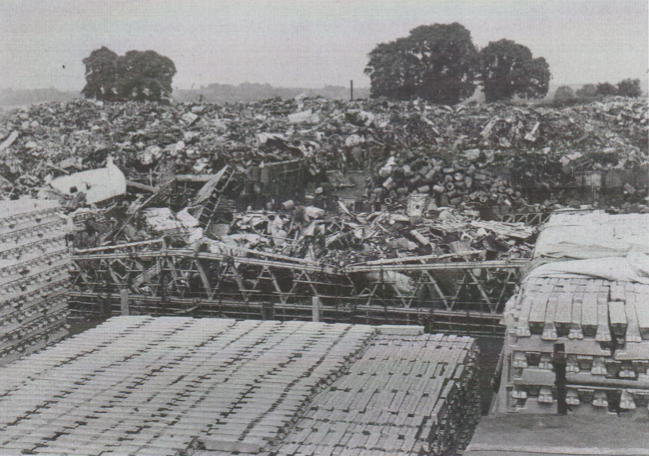
[Photo: Morris Motors Archive]
A wartime view of the MPRD "scrapfield" with Horspath and Shotover Hill in the background. In the foreground are stacks of reclaimed aircraft grade aluminium, while the centre ground is occupied by piles of scrap material of all kinds prior to sorting and reclaiming.
Some M.P.R.D. Statistics
Opened in June, 1940, the site increased to being a mile long by about a third of a mile, about 71 acres at its maximum in 1945. The gigantic piles of smashed aircraft, 20 feet high, were not finally cleared until 1947.
Around 8 miles of road were constructed within this site (with names such as Spitfire, Hurricane, Mosquito & Halifax Roads). A railway spur from the Oxford line was also provided into the MPRD compound.
A little later into the war a gigantic smelting plant was constructed, together with ten large sheds for the breaking down all the various component materials recovered.
Aluminium ingots in the first year of recovery and smelting produced 882 tons of ingots; this had risen to 6,662 tons in 1944. The total amount produced totalled 25,000 tons.
Additionally, during its life, MPRD also produced 70,000 tons of non-ferrous materials, together with the valuable recycling of 2,000 tons of re-usable aircraft components.
A laboratory was established within Pressed Steel to analyse the wide range of materials recovered. A Dr. Bramley was in charge, with Mr E A Rayner overseeing chemistry. Analysis was undertaken by Miss McLoughlin (copper), Miss Lydia Higgins (zinc), and Miss Doreen Hewitt (iron). Spectrophotometry was in the hands of John Neville and Gordon Parker.
Interesting Aircraft
Some interesting aircraft which found their way to MPRD included:

Deputy Reichsfuhrer Rudolf Hess's Bf110E VJ+OQ (Werk No. 3869)
On the evening of 10th May, 1941, Rudolf Hess (Hitler's deputy), took off alone from Augsberg on a secret flight to Scotland, where he hoped to be able to open talks about the future wartime situation between Britain and Germany; possibly on behalf of Hitler, but the whole affair was shrouded in mystery! Just after crossing the Farne Islands, he failed to locate his landing area and was forced to bale out, landing in a field and was arrested by a farmer. His aircraft crashed and the true significance of the unexpected visitor by parachute quickly alerted the authorities. 43 Group told No. 50 Maintenance Unit at Cowley to expect this aircraft (a twin-engine Messerschmitt Bf110 fighter) as a Top Secret activity, and the wreckage was collected by them and brought to Cowley at MPRD, covered over and inconspicuous. Shortly after its arrival, the Superintendent at 50MU received a telephone call, telling him to put the wreckage on display in St Giles, Oxford, with boards announcing to all and sundry what it was! This was duly done, but caused extreme consternation in high places: the true authority for this embarrassing action was never revealed. Back at MPRD the wreckage was certainly not reduced to scrap, and today the two engines and part of the fuselage still exist, held by the RAF Museum and Imperial War Museum. There is probably a great deal more existing; this very interesting aircraft could not have escaped the souvenir hunters after its very public appearance in central Oxford! The photograph above shows the aircraft as it arrived at Cowley from Scotland.
Further information about Hess's plane will be found in Part 3, below.
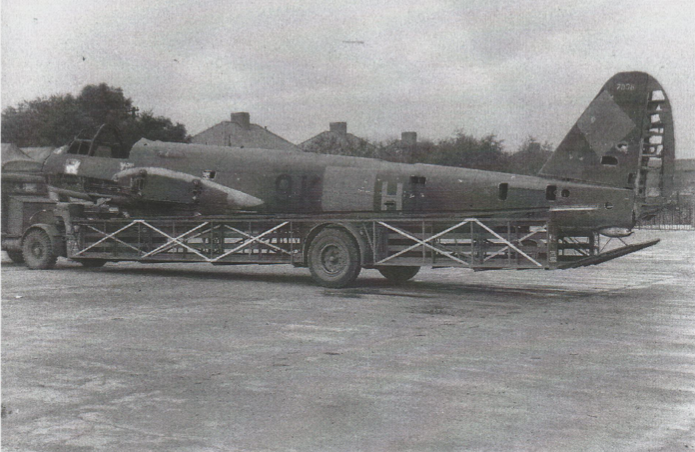
Junkers 88 bomber 9K+HL, Werk. No. 7036.
This bomber took off from near Paris on the evening of 28th July, 1940, but got very lost and very nearly flew to Dublin! Turned east towards London, but being disorientated thought it was Paris, so they turned south for their home airfield, but in reality they were over the south coast! Ran out of fuel, jettisoned their bombs and crash-landed at Buckholt Farm near Redhill. The aircraft sustained some machine-gun fire (seen in the photo), but was almost intact on landing. It was dismantled and taken by road to Cowley, and photographed on a 50MU trailer. It was taken to Farnborough, rebuilt and given RAF markings as AX919. It first flew again in April 1941, and it was eventually broken up for spares at Duxford for No. 1426 Enemy Aircraft Flight. Another aircraft which flew on both sides!
MPRD Project - Part 2
The following image, from the USAAF taken April 1944, shows the MPRD from the air with Horspath on the left.
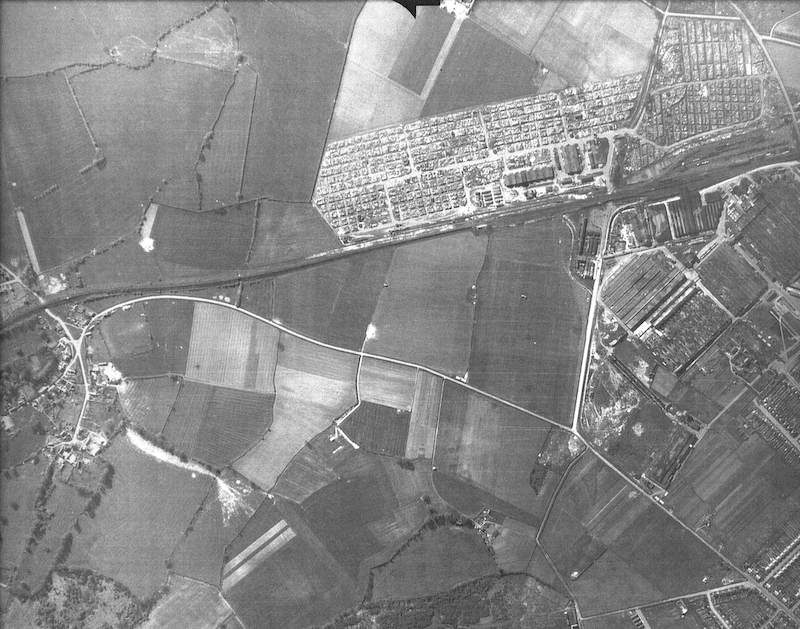
USAAF image from April 1944
A similar image, from the Morris Motors archive, shows the MPRD from the air (undated). The railway line can be seen at the top of the dump. The "thing" that appears to be a bomb crater at the bottom left is probably a photographic defect, there is no record of bombs being dropped on the MPRD.
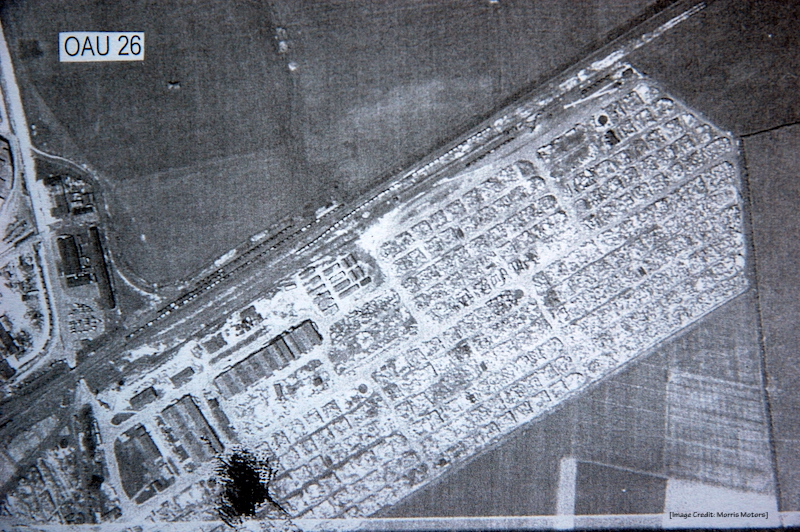
MPRD from Morris Motors archive
The dump was huge and contained many different types of aircraft. The next image shows a small portion of the dump with a German aircraft waiting to be dismembered.
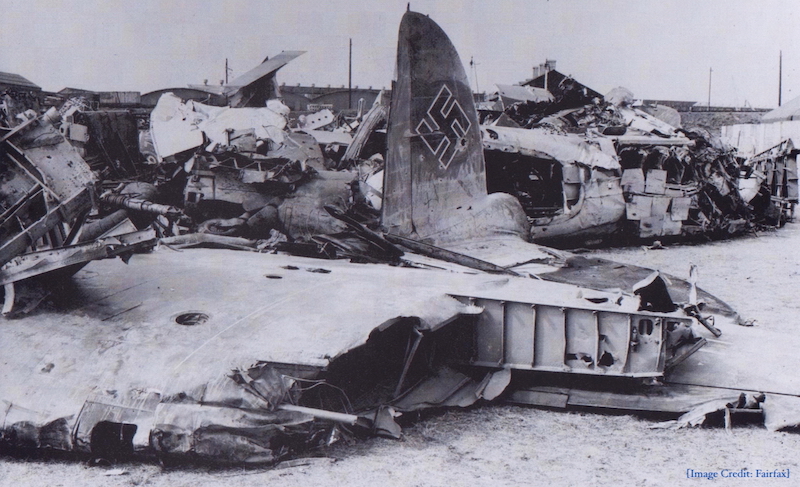
German aircraft in dump
The work in breaking up the aircraft was labour intensive as can be seen from the following image of men dismantling an aircraft wing.
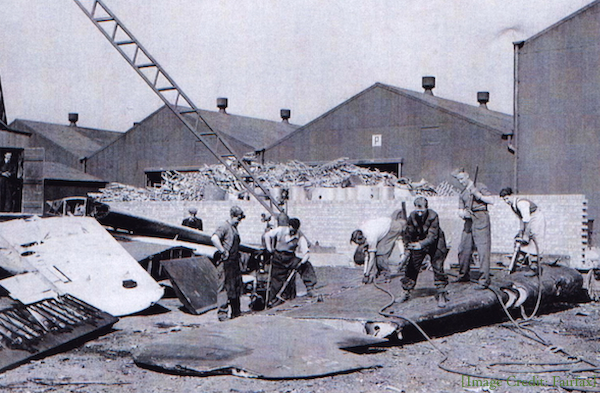
Dismantling an aircraft wing
The objective of the MPRD was to recover as much of the valuable aircraft-grade aluminium as possible, and also to recycle the truly vast amounts of technical equipment from the downed aircraft. Parts recovered from the dump were also used for repairing damaged aircraft.
The following is extracted from:
"WW2 People's War" An archive of World War Two memories.
Memories of the Home Front in Oxford by Laura Garcia
At MPRD the wrecked aircraft were piled alongside alleyways over a vast area, SE of the Cowley railway line.
Usable items and materials were taken from them. The remaining wreckage was then cut up in the main workshops, NW of the railway.
Aluminium for the manufacture of new aircraft was in very short supply. Hence everything that was made predominantly of aluminium alloys went to the foundry,
where it was fed by hand into round pots (later in the war replaced by much bigger furnaces).
The molten aluminium was then ladled into moulds to form ingots about the size of two building bricks.
The purity of the recovered aluminium was of crucial importance. Hence, in a small workshop each ingot was sampled by drilling
and some of the swarf placed in a numbered paper bag. This then went to the laboratory which was in a brick building adjacent to the foundry.
MPRD, including the laboratory, continued in existence after the war to complete disposal of the accumulated wreckage.
- - - - - - - - - -
In early September 2025, John Reid from Warwick contacted us with his memories of the MPRD.
Recollections of the Metal Products Recovery Department - MPRD Horspath Cowley Oxford
I was born in 1941 and the family home was, in those days, the last house, No.20, in Newman Road, Littlemore. A short walk from the end of Newman Road lead, after crossing the Cowley Littlemore/Sandford Road, to the bottom end of Long Lane, the top end of which was adjacent to the Cowley Stadhampton Road, itself being close to the Garsington Road which was one side of the MPRD dump.
Dad used to take me for walks up Long Lane sometime as far as the dump.
I just remember seeing all the scrap metal and in particular the tail end/gun turret of an aircraft sticking up in the air.
Much later when I became interested in WW2 aircraft, I believe it could have been that of a Sunderland flying boat.
It is difficult to put a precise date on my trips but I understand that the dump closed in 1947. Does this mean it was closed and cleared in that year or that it did not receive any more wrecks after this date? I often wondered about this as in 1945 I was only 4 so 6 in 1947 and it was a long walk for a young child from one end of the lane to the other. It is possible that Dad took me on his bike though I have no recollection of this.
In September 1959 I entered Pressed Steel as an Engineering Student Apprentice and finished up working in the Structures Department. The employees’ car park was adjacent to and was probably part of the old MPRD. Access was down a turning off the Horspath Road known then as the Roman Road.
One of the projects I worked on was a prefabricated 2 storey steel house made up of interlocking beams and pressed preformed walls. It was assembled in one of the old MPRD sheds. The whole area in my time at Pressed Steel 1959-66 was still known as MPRD and was used mainly for storage together with a workshop/garage for company vehicles.
- - - - - - - - - -
A huge amount of aluminium was recovered from the crashed aircraft, melted down, and poured into moulds. The image below shows molten aluminium being poured into moulds and the ingots were stored outside in large stacks.
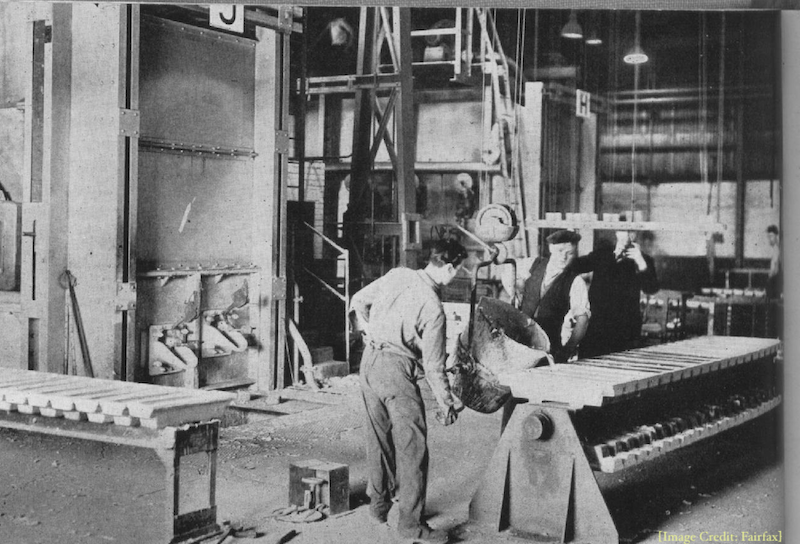
Pouring Aluminium into moulds
The following image shows some of the stacks of aluminium ingots waiting to be sent out to factories.
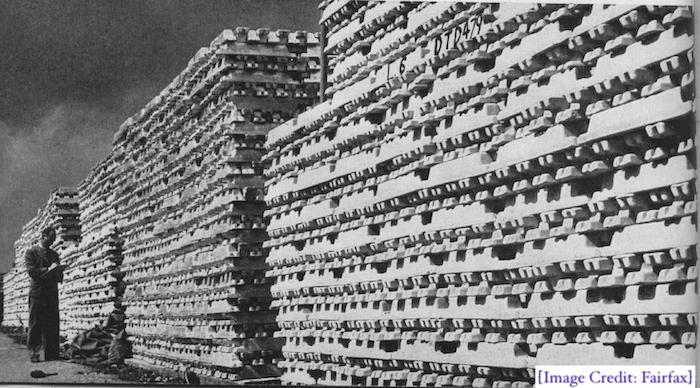
Aluminium Stacks
It's reckoned that the MPRD salvaged enough aluminium and technical equipment to create over five thousand new aircraft during the war; a truly major contribution to survival of this country, and one we believe deserves wider recognition.
MPRD Project - Part 3
The following information and images were supplied by Nigel Parker.
The images below show a navigation instrument salvaged from Hess's aircraft which was presented to the Norwegian engineer
who designed the engine for the Morris 7, Hans Landstad. For further information about this interesting character see this website:
Hans Landstad and the Hafner family.
Nigel is now the owner of the instrument having been the only bidder for it at auction a few years ago.
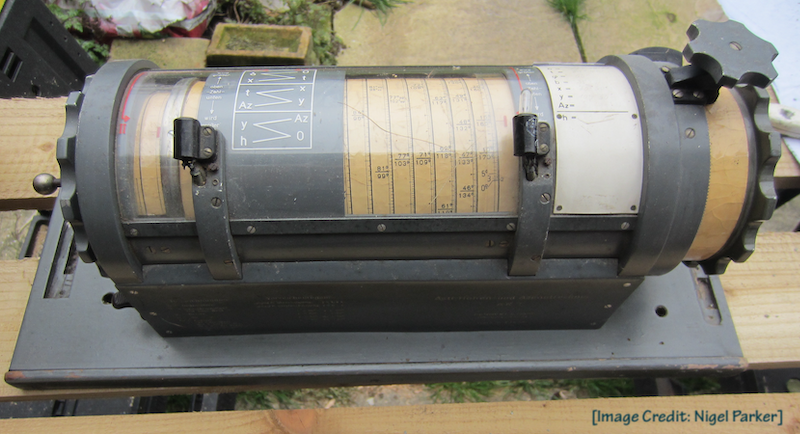
Navigation instrument from Hess's plane.
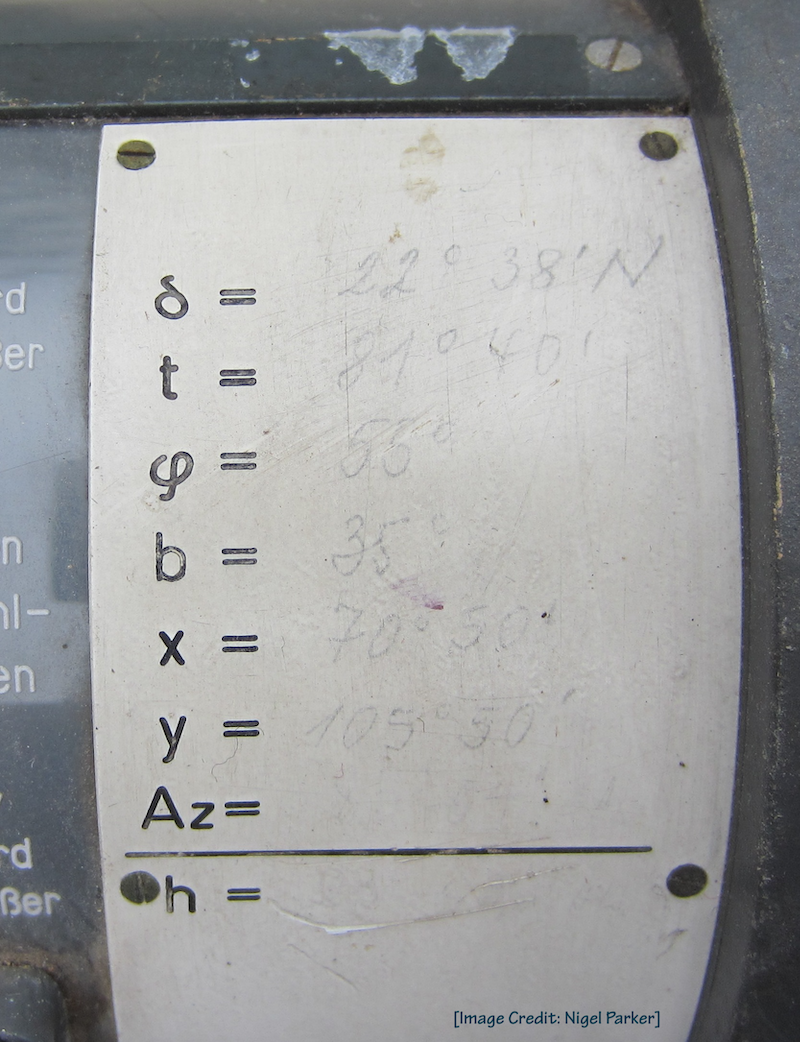
Navigation instrument showing Hess's plot for the journey.
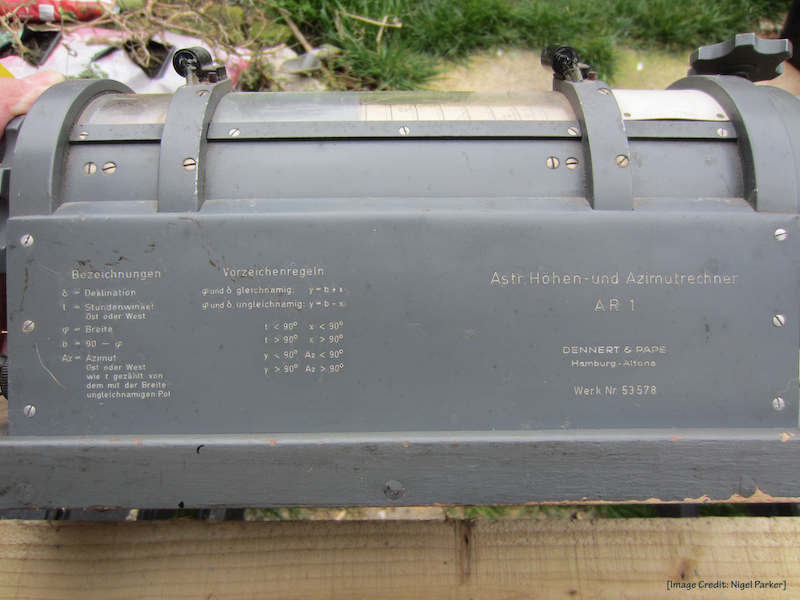
Navigation instrument - side view.
This instrument was an astronomical calculator which used slide-rule techniques to navigate by the stars to a predetermined destination. The "Astr. Hohen- und Azimutrechner AR1" was manufactured by the company Dennart & Pape of Hamberg-Altona founded by Johann Christian Dennart and Martin Pape in 1863.
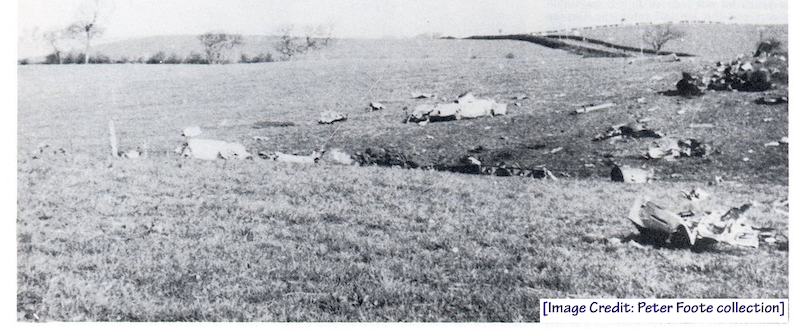
The crash site where Rudolf Hess's plane came down on the 10th May 1941 in Scotland. He landed at Floors Farm, by Waterfoot, south of Glasgow. [Peter Foote collection]

Inspecting the debris.
[Peter Foote collection]
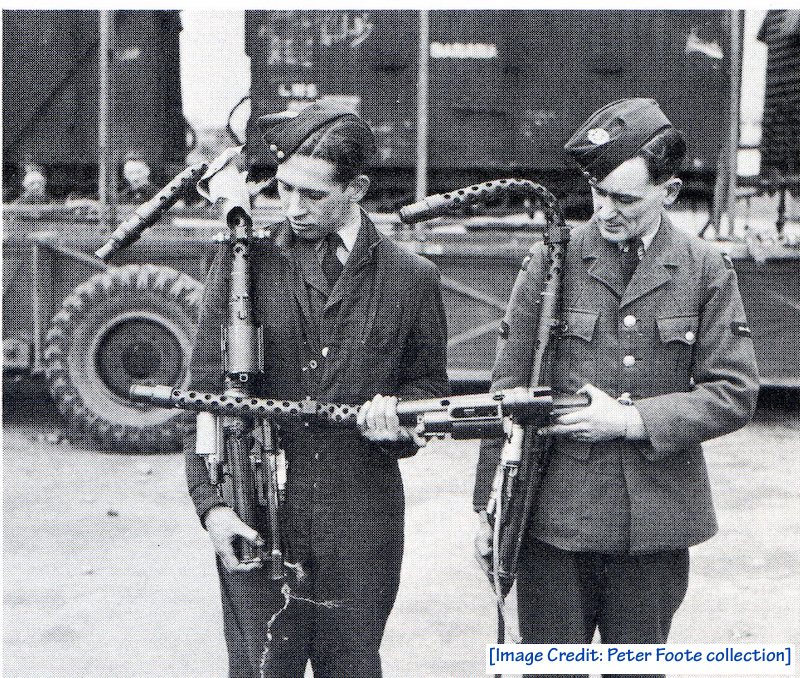
The recovered guns were slightly bent! [Peter Foote collection]
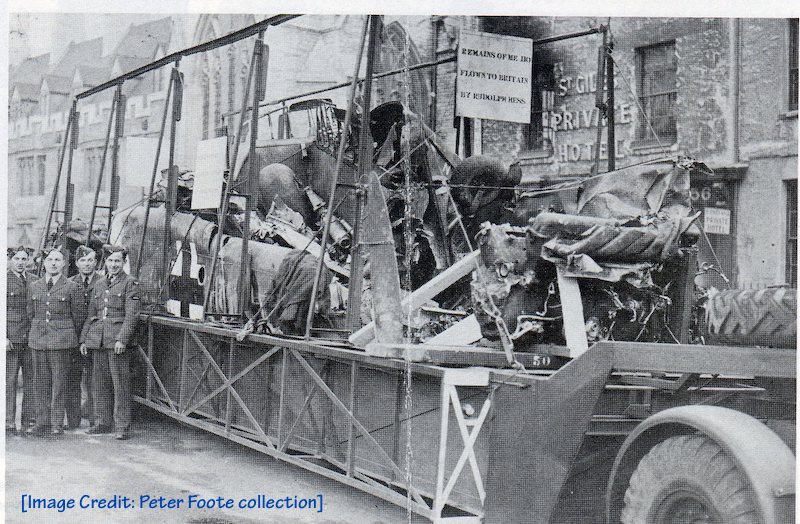
Rudolf Hess's plane was displayed at St. Giles for a time. [Peter Foote collection]
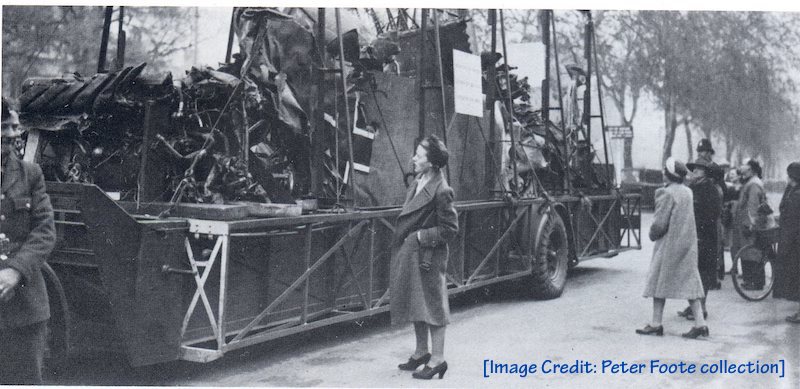
Rudolf Hess's plane was displayed at St. Giles for a time. [Peter Foote collection]